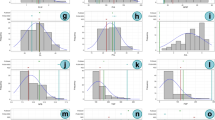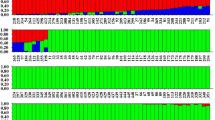Abstract
Microsatellite (SSR) markers can reveal a high level of polymorphic loci, and are increasingly being used in population genetic structure studies. On the Vientiane plain of Laos all components of the rice crop complex exist, wild annual (O. nivara), wild perennial (O. rufipogon) and weedy relatives of rice as well as rice itself. To understand gene flow in the rice complex, the genetic structures of O. rufipogon (10 populations), O. nivara (10 populations) and O. sativa (24 samples) from across the Vientiane Plain, Laos, were compared. Higher genetic differentiation was detected among O. nivara populations (G ST = 0.77, R ST = 0.71) than O. rufipogon populations (G ST = 0.29, R ST = 0.28), whereas genetic diversity for all populations of these two wild species showed similar values (H T = 0.77 and 0.64 in O. rufipogon and O. nivara, respectively). Based on neighbor-joining tree constructed on the basis of genetic distance (D A), three genetic clusters were detected, corresponding to (1) O. sativa samples, (2) O. nivara populations and (3) O. rufipogon populations. Pairwise tests confirmed the genetic differentiation of the three species. Although none of the wild rice individuals used in this study had any cultivated-specific phenotypic traits, genetic admixture analysis detected more than 10% O. sativa membership in three O. rufipogon and one O. nivara populations, indicating that O. sativa alleles may cryptically persist in natural populations of O. rufipogon and O. nivara on the Vientiane Plain.
Similar content being viewed by others
References
Akimoto M, Shimamoto Y, Morishima H (1999) The extinction of genetic resources of Asian wild rice, Oryza rufipogon Griff.: a case study in Thailand. Genet Res Crop Evol 46:419–425
Appa Rao S, Bounphanousay C, Shiller JM, Jackson MT (2000) Collection and Classification of Rice Germplasm from the Lao PDR from 1995 to 2000. National Rice Research Program and Lao-IRRI Biodiversity Project, p 576
Barbier P (1989a) Genetic variation and ecotypic differentiation in the wild rice species Oryza rufipogon. I. Population differentiation in life-history traits and isozymic loci. Jpn J Genet 64:259–271
Barbier P (1989b) Genetic variation and ecotypic differentiation in the wild rice species Oryza rufipogon. II. Influence of the mating system and life-history traits on the genetic structure of populations. Jpn J Genet 64:273–285
Bossart JL, Prowell DP (1998) Genetic estimates of population structure and gene flow: limitations, lessons and new directions. Trends Ecol Evol 13:202–206
Brar DS, Khush GS (1997) Alien introgression in rice. Plant Mol Biol 35:35–47
Brown AHD (2000) The genetic structure of crop landraces and the challenge to conserve them in situ on farms. In: Brush SB (ed) Genes in the field: on-farm conservation of crop diversity. IDRC/IPGRI, Lewis, pp 29–48
Cai HW, Wang XK, Morishima H (2004) Comparison of population genetic structures of common wild rice (Oryza rufipogon Griff.), as revealed by analyses of quantitative traits, allozymes, and RFLPs. Heredity 92:409–417
Chen WB, Nakamura I, Sato YI, Nakai H (1993) Distribution of deletion type in cpDNA of cultivated and wild rice. Jpn J Genet 68:597–603
Chen X, Temnykh S, Xu Y, Cho YG, McCouch SR (1997) Development of a microsatellite framework map providing genome-wide coverage in rice (Oryza sativa L.). Theor Appl Genet 95:553–567
Cheng C, Motohashi R, Tsuchimoto S, Fukuta Y, Ohtsubo H, Ohtsubo E (2003) Polyphyletic origin of cultivated rice: based on interspersion pattern of SINEs. Mol Biol Evol 20:67–75
Chu YE, Morishima H, Oka HI (1969) Reproductive barriers distributed in cultivated rice species and their wild relatives. Jpn J Genet 44:207–223
Gao LZ (2004) Population structure and conservation genetics of wild rice Oryza rufipogon (Poaceae): a region-wide perspective from microsatellite variation. Mol Ecol 13:1009–1024
Goudet J (2001) FSTAT, a program to estimate and test gene diversities and fixation indices (version 2.9.3). Available from http://www.unil.ch/izea/softwares/fstat.html Updated from Goudet (1995)
Hamrick JL, Godt MJW (1989) Allozyme diversity in plant species. In: Brown AHD, Clegg MT, Kahler AL, Weir BS (eds) Plant population genetics, breeding and genetic resources. Sinauer Association Inc., Sunderland, pp 43–63
Haig SM (1998) Molecular contributions to conservation. Ecology 79:413–425
Harlan JR (1975) Crops and man. American Society of Agronomy Inc., Madison, Wisconsin, p 295
Jarvis DI, Hodgkin T (1999) Wild relatives and crop cultivars: detecting natural introgression and farmer selection of new genetic combinations in agroecosystems. Mol Ecol 8:S159–S173
Kuroda Y, Urairong H, Sato YI (2003) Population genetic structure of wild rice (Oryza rufipogon) in mainland Southeast Asia as revealed by microsatellite polymorphisms. Tropics 12:159–170
Kuroda Y, Urairong H, Sato YI (2005a) Differential heterosis in a natural population of Asian wild rice (Oryza rufipogon) due to reproductive strategy and edge effect. Genet Res Crop Evol 52:151–160
Kuroda Y, Sato YI, Bounphanousay C, Kono Y, Tanaka K (2005b) Gene flow from cultivated rice (Oryza sativa L.) to wild Oryza species (Oryza rufipogon Griff. and O. nivara Sharma & Shastry) on the Vientiane Plain of Laos. Euphytica 142:75–83
Lei X (2004) China could be first nation to approve sale of GM rice. Science 306:1458–1459
Lu BR, Snow AA (2005) Gene flow from genetically modified rice and its environmental consequences. Bioscience 55:669–678
McCouch SR, Temnykh S, Lukashova A, Coburn J, DeClerck G, Cartinhour S, Harrington S, Thomson M, Septiningsih E, Semon M, Moncada P, Li J (2001) Microsatellite markers in rice: abundance, diversity, and applications. In: Khush GS, Brar DS, Hardy B (eds) Rice genetics IV. Science Publishers Inc. International Rice Research Institute Los Baños, Philippines, pp 117–135
Morishima H, Barbier P (1990) Mating system and genetic structure of natural populations in wild rice Oryza rufipogon. Plant Species Biol 5:31–39
Murray MG, Thompson WF (1980) Rapid isolation of high molecular weight plant DNA. Nucleic Acids Res 8:4321–4325
Nei M (1978) Estimation of average heterozygosity and genetic distance from a small number of individuals. Genetics 89:583–590
Nei M (1987) Molecular Evolutionary genetics. Columbia Univ. Press, New York
Nei M, Tajima F, Tateno Y (1983) Accuracy of estimated phylogenetic trees from molecular data. J Mol Evol 19:153–170
Oka HI (1988) Origin of cultivated rice. Japan Scientific Societies Press /Elsevier, Tokyo, p 254
Oka HI, Chang WT (1961) Hybrid swarms between wild and cultivated rice species, Oryza perennis and O. sativa. Evolution 15:418–430
Page RDM (1996) TREEVIEW: An application to display phylogenetic trees on personal computers. Comput Appl Biosci 12:357–358
Panaud O, Chen X, McCouch SR (1996) Development of microsatellite markers and characterization of simple sequence length polymorphism (SSLP) in rice (Oryza sativa L.). Mol Gen Genomics 252:597–607
Parker PG, Snow AA, Schug MD, Booton GC, Fuerst PA (1998). What molecules can tell us about populations: choosing and using a molecular marker. Ecology 79:361–382
Pritchard JK, Stephens M, Donnelly P (2000) Inference of population structure using multilocus genotype data. Genetics 155:943–959
Rousset F (1996) Equilibrium values of measures of population subdivision for stepwise mutation processes. Genetics 142:1357–1362
Sharma SD, Shastry SVS (1965) Taxonomic studies in genus Oryza L. III. O. rufipogon Griff. sensu stricto and O. nivara Sharma et Shastry nom nov. Indian J Genet Plant Breed 25:157–167
Slatkin M (1995) A measure of population subdivision based on microsatellite allele frequencies. Genetics 139:457–462
Song ZP, Lu BR, Zhu YG, Chen JK (2003a) Gene flow from cultivated rice to the wild species Oryza rufipogon under experimental field conditions. New Phytol 157:657–665
Song ZP, Xu X, Wang B, Chen JK, Lu BR (2003b). Genetic diversity in the northernmost Oryza rufipogon populations estimated by SSR markers. Theor Appl Genet 107:1492–1499
Takezaki N, Nei M (1996) Genetic distances and reconstruction of phylogenetic trees from microsatellite DNA. Genetics 144:389–399
Vargo EL, Husseneder C, Grace K (2003) Colony and population genetic structure of the Formosan subterranean termite, Coptotermes formosanus, in Japan. Mol Ecol 12:2599–2608
Vaughan DA (1994) The wild relatives of rice; a genetic resources handbook. International Rice Research Institute, Los Baños, Philippines, p 137
Vaughan DA, Chang TT (1992) In situ conservation of rice genetic resources. Econ Bot 46:368–383
Weir BS (1996) Genetic data analysis II: methods for discrete population genetic data. Sinauer Associates Inc., Sunderland, Massachusetts
Weir BS, Cockerham CC (1984) Estimating F-statistics for the analysis of population structure. Evolution 38:1358–1370
Westemeier RL, Brawn JD, Simpson SA, Esker TL, Jansen RW, Walk JW, Kershner EC, Bouzat JL, Paige KN (1998) Tracking the long-term decline and recovery of an isolated population. Science 282:1695–1698
Wright S (1965) The interpretation of population structure by F-statistics with special regard to systems of mating. Evolution 19:395–420
Acknowledgements
This research was supported in part by a grant from the Toyota foundation. We would like to acknowledge here the generosity of the Lao government, the National Agricultural Research Center (NARC, Laos), the National Agriculture and Forestry Institute (NAFRI, Laos), the Ministry of Agriculture (MAF, Laos), and the Lao-IRRI project for permission to conduct a field survey in the Vientiane plain of Laos.
Author information
Authors and Affiliations
Corresponding author
Rights and permissions
About this article
Cite this article
Kuroda, Y., Sato, YI., Bounphanousay, C. et al. Genetic structure of three Oryza AA genome species (O. rufipogon, O. nivara and O. sativa) as assessed by SSR analysis on the Vientiane Plain of Laos. Conserv Genet 8, 149–158 (2007). https://doi.org/10.1007/s10592-006-9156-3
Received:
Accepted:
Published:
Issue Date:
DOI: https://doi.org/10.1007/s10592-006-9156-3




